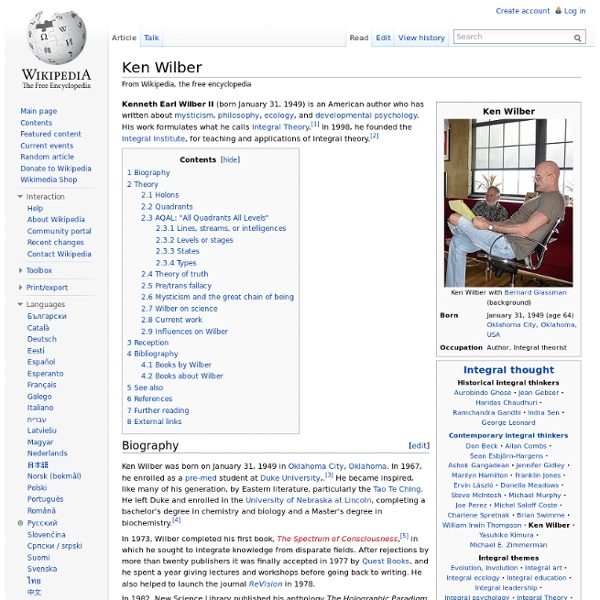Integral theory
Integral theory, a philosophy with origins in the work of Sri Aurobindo and Jean Gebser, and promoted by Ken Wilber, seeks a synthesis of the best of pre-modern, modern, and postmodern reality.[1] It is portrayed as a "theory of everything,"[2] and offers an approach "to draw together an already existing number of separate paradigms into an interrelated network of approaches that are mutually enriching."[1] It has been applied by scholar-practitioners in 35 distinct academic and professional domains as varied as organizational management and art.[1] Methodologies[edit] AQAL, pronounced "ah-qwul," is a widely used framework in Integral Theory. Sri Aurobindo, Jean Gebser, and Ken Wilber, have all made significant theoretical contributions to integral theory. In his book The Ever-Present Origin, Swiss phenomenologist Jean Gebser distinguished between five structures of consciousness: archaic, magic, mythical, mental, and integral. AQAL Theory – Lines. Principles and Properties: Themes[edit] H.
ConceptNet 5
Meme
"Memes" redirects here. For the weevil genus known as Memes, see Hylobiini. A meme (/ˈmiːm/ meem)[1] is "an idea, behavior, or style that spreads from person to person within a culture."[2] A meme acts as a unit for carrying cultural ideas, symbols, or practices that can be transmitted from one mind to another through writing, speech, gestures, rituals, or other imitable phenomena with a mimicked theme. Supporters of the concept regard memes as cultural analogues to genes in that they self-replicate, mutate, and respond to selective pressures.[3] The word meme is a shortening (modeled on gene) of mimeme (from Ancient Greek μίμημα Greek pronunciation: [míːmɛːma] mīmēma, "imitated thing", from μιμεῖσθαι mimeisthai, "to imitate", from μῖμος mimos "mime")[4] and it was coined by the British evolutionary biologist Richard Dawkins in The Selfish Gene (1976)[1][5] as a concept for discussion of evolutionary principles in explaining the spread of ideas and cultural phenomena. Origins Memetics
Causality Experts
A short history of British Anarcho-syndicalism
Origins and ideas of anarcho-syndicalism Anarcho-syndicalism is a distinct school of thought within anarchism. It seeks to abolish the wage system and private ownership of the means of production which lead to the class divisions in society. The three important principles of anarcho-syndicalism are solidarity, direct action and workers' self-management. The origins of anarcho-syndicalism can be traced back to the First International, also known as the International Workingmen's Association (IWA), formed in 1864. After the demise of the International and the period of repression following the defeat of the Paris Commune, there was a move by some anarchists towards propaganda by deed to bring about change. Many anarchists though saw the futility of individual action that had alienated them from the working class and sought to re-enter and influence a re-emerging labour movement. They rejected the idea of “theorising” as an abstract exercise. These ideas were taken up as early as 1894.
Judea Pearl
Judea Pearl (born 1936) is an Israeli-born American computer scientist and philosopher, best known for championing the probabilistic approach to artificial intelligence and the development of Bayesian networks (see the article on belief propagation). He is also credited for developing a theory of causal and counterfactual inference based on structural models (see article on causality). He is the 2011 winner of the ACM Turing Award, the highest distinction in computer science, "for fundamental contributions to artificial intelligence through the development of a calculus for probabilistic and causal reasoning".[1][2][3][4] Judea Pearl is the father of journalist Daniel Pearl, who was kidnapped and murdered by militants in Pakistan connected with Al-Qaeda and the International Islamic Front in 2002 for his American and Jewish heritage.[5][6] Biography[edit] Pearl is currently a professor of computer science and statistics and director of the Cognitive Systems Laboratory at UCLA. Books[edit]
Syndicalism
Syndicalism is a type of proposed economic system, a form of socialism, considered a replacement for capitalism. It suggests that industries be organised into confederations or syndicates. It is "a system of economic organization in which industries are owned and managed by the workers."[1] Syndicalism is also used to refer to the tactic of bringing about this social arrangement, typically expounded by anarcho-syndicalism and De Leonism. Theory[edit] Basic outline of syndicalism as an economic system. Syndicalism is one of the three most common currents of socialist economics, together with market socialism and socialist planned economies. Syndicalists state that society ought to be organised bottom-up based on direct democracy, confederation, workplace democracy and decentralised socialism. Syndicalism and anarcho-syndicalism[edit] Related theories include anarchism, socialism, Marxism, Leninism, and communism. History[edit] See also[edit] [edit] Further reading[edit] External links[edit]
Foster Gamble
Anarchism in Spain
Anarchism in Spain has historically gained more support and influence than anywhere else, especially before Francisco Franco's victory in the Spanish Civil War of 1936–39. There were several variants of anarchism in Spain: expropriative anarchism in the period leading up to the conflict, the peasant anarchism in the countryside of Andalusia; urban anarcho-syndicalism in Catalonia, particularly its capital Barcelona; and what is sometimes called "pure" anarchism[clarification needed] in other cities such as Zaragoza. However, these were complementary trajectories, and shared a great deal of ideological similarities. Early on, the success of the anarchist movement was sporadic. In the 20th century, this violence began to fade, and the movement gained speed with the rise of anarcho-syndicalism and the creation of the huge libertarian trade union, the Confederación Nacional del Trabajo (CNT). Anarchists played a central role in the fight against Francisco Franco during the Spanish Civil War.



